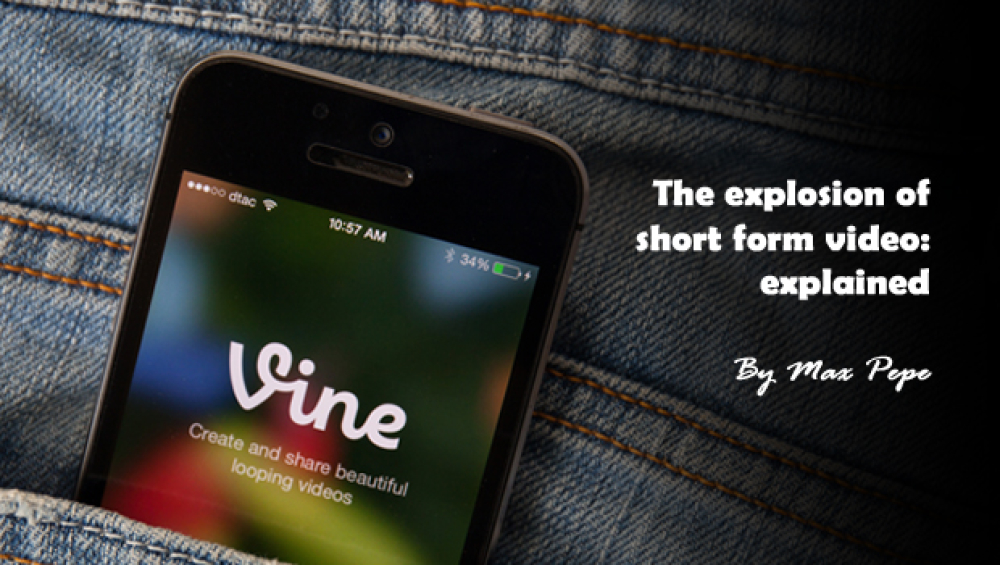The explosion of short form video, explained
02 Oct 2015

In order to win the coveted attention of millennials, savvy brands need to master the art of short form video creative. Platforms such as Vine, Instagram and Snap Chat have captured the imagination of today’s youth, purposefully limiting video length to somewhere between 6 - 15 seconds dependent on the platform itself. The reality now, when it comes to video, is that late adopters of short form video are failing to engage, YouTube alone simply isn't enough as part of an holistic digital video strategy.
Vine is the flagship short-form video platform, and limits video clips to only 6 seconds. It was acquired by Twitter in 2012, and by April 2013 was the single most downloaded app in the App Store. It now has over 40 million global active users on its platform, of which over 65% are between 15 – 20 years old, and there are 1.5 billion Vine loops played on a daily basis.
In a recent study it was found that 31.8% of all US teenagers use Vine regularly, and over 100 million people worldwide watch a Vine video every month.
Millennials are certainly the key adopters of this platform, and it’s not hard to see why. They are intrinsically instilled with a technological instinct and awareness that has, in a digitally-Darwinian-manner, evolved as a necessary communication and social survival tool among their peers. (I tweet therefore I am). Social status is more and more prevalently awarded, generated, validated and judged through both hard and soft technology i.e. ownership of physical gadgets and presence on social media.
In-built content consumption processors within the minds of Millennials have adapted in an equally transformative way. How can one possibly survive in a world where limitless quantities of information are accessible every second of the day? A world where a ceaseless abundance of content is propelled into our palms and shot onto our screens at an unfathomable rate.
Gen Y have adapted and developed a highly advanced (yet profoundly unconscious) filtering system. They are required to make thousands of micro decisions every second. ‘Should I click, should I watch, should I share, should I like?’. Commonly, ignorantly and patronisingly mistaken for some sort of consumer A.D.D or short attention span syndrome, this filter is in fact an integral part of digital survival. It enables the Millennial to sift through the content glut and extract from it that which he or she deems to be relevant.
Furthermore, not only are their peers competing for attention, but of course, so are hundreds of thousands of brands and advertisers.
Consider this an ‘attention’ market place if you will, and contemplate the basic premise of supply and demand. What we witness here is an outrageously disproportionate amount of supply (i.e. content) compared to the available amount of demand (i.e. consumer attention).
In response to this overwhelming crowded vista, and attune to the chaotic landscape that the Millennial occupies, Vine provided a beautifully uncomplicated solution. This solution was quite simple - limit options.
By ensuring every video cannot exceed 6 seconds in length, Vine managed to reduce the sense of commitment one may feel when pressing play. The risk associated to investing six seconds of time on a video is not a scary one (what’s the worse than can happen?). A decision is easier when there are less choices. A 6 second video gets a green light from Millennials and by-passes their filtering system.
It is therefore little surprise that the exponential growth of short-form video can be virally attributed to the Millennials propensity to ‘share’ and ‘tweet’ such content. To put this in perspective, 5 vines are Tweeted every second (3), 1 in 5 tweets contains a vine link (10) and 12 million vine videos uploaded to Twitter on a daily basis. This presents a gargantuan opportunity for advertisers to gain mass exposure, and build audiences through brand advocates.
Attention received and a platform for successful two- way communication established. The door is now open for brands to engage with Millennials.
The 6-second limited video length creates an eco-system that forces a new breed of content creation. Succinct, punchy and memorable. Brands must learn how to master this art and build an audience, not a customer base, through short form video.
Quality of content really is the only magic ingredient needed. It stands to reason therefore that the likes of Red Bull and GoPro are utilising this channel better than any other brand at present, as their content virtually creates itself.
But not all brands are created equal in this sense. We as marketers need to dig deep. We need to understand our audience, understand the platforms, and most importantly understand our brands well enough to extract engaging content and turn it in to a constant stream of short form video.
Branded content already accounts for 4% of the top 100 tracked vines (10), and brands will get up to 400% more shares from their Vine videos than they will from standard branded videos (9). But still the size and scale of this opportunity has only just begun to unravel.
Please login to comment.
Comments